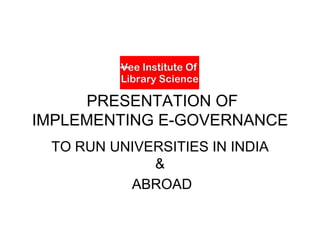Vils presentation of implementing e governance
- 1. VILS PRESENTATION OF IMPLEMENTING E-GOVERNANCE TO RUN UNIVERSITIES IN INDIA & ABROAD
- 2. UNIVERSITY DIVISIONS & DEPARTMENTS • • • • • • Top Management Vice-Chancellor’s Office Faculties/Schools Library University Administration Students’ Facilities
- 3. TOP MANAGEMENT CHANCELLOR ACADEMIC COUNCIL EXECUTIVE COUNCIL BOARD OF STUDIES
- 4. VICE-CHANCELLOR’S OFFICE VICE-CHANCELLOR RECCTOR/ PRO VICE_CHANCELLOR 1 RECCTOR/ PRO VICE-CHANCELLOR2 RECCTOR/ PRO VICE-CHANCELLOR N
- 5. Faculties/Schools Faculty/School of: • Social Science • And, International Relations • Science • Or, Life Sciences • And, Computer Science • And, Biotechnology • And, Environmental Science • Arts & Aesthetics • Law and Governance • Faculty/School of Engineering • Physical Science • Languages, Literature and Cultural Studies
- 6. Faculty of Social Science: An Example • Department/Center of Psychology • Department/Center of Education • Department/Center of Geography • Department/Center of History • Department/Center of Politics • Department/Center of Economics • Department/Center of Sociology • Department/Center of Law
- 7. University Library • OFFICE OF THE LIBRARIAN • MEMBERSHIP AND ISSUE & RETURN • LIBRARY ADMINISTRATION • REFERENCE • CATALOGING • MAINTENANCE • SOCIAL SCIENCE LIBRARY • SCIENCE LIBRARY • GOVERNMENT /UN DOCUMENTS • PRESS CLIPPINGS • DOCUMENTATION • ARCHIVES • SERIALS • TEXT BOOKS AND RESERVE
- 8. UNIVERSITY ADMINISTRATION • Office of the Registrar • Office of the Controller of Examination/Coordinator • Office of the Finance Officer
- 9. University Facilities • • • • • • • Health Center Sports Conference and Seminar Halls Guest Houses Theater and Clubs University Security Hostels and Married Hostels
- 10. Publication Division • • • • University Press University Editorial Board University Magazine Section Examination Papers and Results Publication Section • Public Relations Office
- 11. WHAT IS E-GOVERNANCE • Use of Information and Communication Technology (ICT) is very essential for Good Governance. The application of ICT in Governance is termed as eGovernance. Therefore we can say , eGovernance is ICT assisted Good Governance’
- 12. UNIVERSITIES • It is very much a requirement for a university to adopt eGovernance protocol in running a university. The advantages of adopting eGovernance protocol in any set up is well known. In adopting it in a University set up has become a necessity.
- 13. PRESENT SCENARIO • Presently the Universities in India are running primarily by files, folders, manuals, which are either handwritten or typed. These files, folders and manuals are kept in conventional manner in file cabinets or pile up indiscriminately on desks of officers and their subordinates, for a considerable period of time, till they are not seen by officers/subordinates, defying their whereabouts.
- 14. SOFTWARE INTERFACE FOR E-GOVERNANCE • A software creates databases of different items, links them and search item/s when required. This is not all, for a software to do. It also ensures elimination of duplication of work. It also links one file to many and also links people on authority to take decisions and be aware of decisions already taken on a subject in the past. They are also being prompted to take decisions by the software to save time. The software also ensures minimum use of paper and stationary. Necessary documents/reports are printed for publication and distribution purposes.
- 15. VILS CONSULTANCY • It is relevant to investigate and know from the university authorities and users what they want to achieve by implementing egovernance protocol to achieve transparency, remove duplication of work and eradicate bureaucracy. In such environment decisions are taken on click of the mouse. A detailed report is submitted by VILS before agreeing to start the work
- 16. VILS CONSULTANCY EXPLAINED SURVE, INTERVIEWS & QUESTINNNARES VILS CONSULTANCY AWARD OF WORK TIME/WORK SCHEDULE & PAYMENT
- 17. WRITING SPECIFICATIONS • On getting the green signal from the University VILS submits a detailed report for each Sector of University Setup, defining in-house links with Divisions/Departments/Faculty and Staff/Officers and outside links with other Universities, agencies, organizations, individuals, for Decision making process
- 18. FIRST LEVEL OF HIERARCHY REGISTRA DEANS R VICCECHANCE LLOR RECTOR S RECTOR S Administratio The n Administratio n The Library Faculties Heads/Cha irpersons of Departmen ts/Centers LIBRARIA N FINANCE OFFICER/ COORDIN ATOR Deputy Librarians Deputy Finance Officer/Depu ty Registrar (Acad) • The Above Table Shows the First Level of hierarchy amongst the Officers • Decisions are Taken on the merit of suggestions given by Junior Officers/Departments to their Seniors • The Decision making process is facilitated by eGovernnce
- 19. VILS KRISHNA 2000: A Case Study Of eGovernance AQUISITION KRISHNA 2000 CATALOGING REFERENCE
- 21. SUGGESTIONS Suggestions are put forward by readers in the library UPDATE SUGGESTIONS They are updated by the library using standard Records SUGGESTIONS Financial implicatio ns are examined AVAILABILITY OF FINANCE SUGGESTED DOCUMENTS A List of Documents is prepared for approval
- 22. ORDERING DOCUMENTS Documents records which are selected to order are sent for sanction electronically to appropriate authorities.The software sends alerts to the sanctioning authority to crosss mark those items which are to rejected to order VENDOR SELECTION SANCTION Vendor selection is done automatically by the software, taking into the account the spciality of the vendor for an item/items and the subject of the document ORDER PLACING ORDERS Vendor-Wise list is generated for placing the order. This is done automatically by the software
- 23. In the end How do you like the presentation? • VILS is always ready to help implementing eGovernance We will be happy to answer your valuable questions and improve our services accordingly • If you deem fit, we will take up the job. • Thank you























